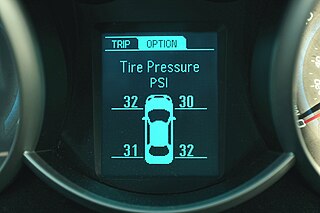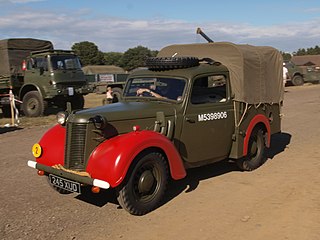
The Lunar Roving Vehicle (LRV) is a battery-powered four-wheeled rover used on the Moon in the last three missions of the American Apollo program during 1971 and 1972. It is popularly called the Moon buggy, a play on the term "dune buggy".

An anti-lock braking system (ABS) is a safety anti-skid braking system used on aircraft and on land vehicles, such as cars, motorcycles, trucks, and buses. ABS operates by preventing the wheels from locking up during braking, thereby maintaining tractive contact with the road surface and allowing the driver to maintain more control over the vehicle.

A tire is a ring-shaped component that surrounds a wheel's rim to transfer a vehicle's load from the axle through the wheel to the ground and to provide traction on the surface over which the wheel travels. Most tires, such as those for automobiles and bicycles, are pneumatically inflated structures, providing a flexible cushion that absorbs shock as the tire rolls over rough features on the surface. Tires provide a footprint, called a contact patch, designed to match the vehicle's weight and the bearing on the surface that it rolls over by exerting a pressure that will avoid deforming the surface.
Automobile handling and vehicle handling are descriptions of the way a wheeled vehicle responds and reacts to the inputs of a driver, as well as how it moves along a track or road. It is commonly judged by how a vehicle performs particularly during cornering, acceleration, and braking as well as on the vehicle's directional stability when moving in steady state condition.

The contact patch is the portion of a vehicle's tire that is in actual contact with the road surface. It is commonly used in the discussion of pneumatic tires, where the term is used strictly to describe the portion of the tire’s tread that touches the road surface. The term “footprint” is used almost synonymously. Solid wheels also exhibit a contact patch which is generally smaller than the pneumatic “footprint”.

Aquaplaning or hydroplaning by the tires of a road vehicle, aircraft or other wheeled vehicle occurs when a layer of water builds between the wheels of the vehicle and the road surface, leading to a loss of traction that prevents the vehicle from responding to control inputs. If it occurs to all wheels simultaneously, the vehicle becomes, in effect, an uncontrolled sled. Aquaplaning is a different phenomenon from when water on the surface of the roadway merely acts as a lubricant. Traction is diminished on wet pavement even when aquaplaning is not occurring.

Rolling resistance, sometimes called rolling friction or rolling drag, is the force resisting the motion when a body rolls on a surface. It is mainly caused by non-elastic effects; that is, not all the energy needed for deformation of the wheel, roadbed, etc., is recovered when the pressure is removed. Two forms of this are hysteresis losses, and permanent (plastic) deformation of the object or the surface. Note that the slippage between the wheel and the surface also results in energy dissipation. Although some researchers have included this term in rolling resistance, some suggest that this dissipation term should be treated separately from rolling resistance because it is due to the applied torque to the wheel and the resultant slip between the wheel and ground, which is called slip loss or slip resistance. In addition, only the so-called slip resistance involves friction, therefore the name "rolling friction" is to an extent a misnomer.

A spoiler is an automotive aerodynamic device whose intended design function is to 'spoil' unfavorable air movement across the body of a vehicle in motion, usually manifested as lift, turbulence, or drag. Spoilers on the front of a vehicle are often called air dams.

A tundra tire is a large low-pressure tire used on light aircraft to allow operations on rough terrain.
Traction, traction force or tractive force is a force used to generate motion between a body and a tangential surface, through the use of either dry friction or shear force. It has important applications in vehicles, as in tractive effort.

The rim is the "outer edge of a wheel, holding the tire". It makes up the outer circular design of the wheel on which the inside edge of the tire is mounted on vehicles such as automobiles. For example, on a bicycle wheel the rim is a large hoop attached to the outer ends of the spokes of the wheel that holds the tire and tube. In cross-section, the rim is deep in the center and shallow at the outer edges, thus forming a "U" shape that supports the bead of the tire casing.

A tire-pressure monitoring system (TPMS) monitors the air pressure inside the pneumatic tires on vehicles. A TPMS reports real-time tire-pressure information to the driver, using either a gauge, a pictogram display, or a simple low-pressure warning light. TPMS can be divided into two different types – direct (dTPMS) and indirect (iTPMS).

Fender is the American English term for the part of an automobile, motorcycle or other vehicle body that frames a wheel well. Its primary purpose is to prevent sand, mud, rocks, liquids, and other road spray from being thrown into the air by the rotating tire. Fenders are typically rigid and can be damaged by contact with the road surface.

The Goodyear Polyglas tire was a bias-belted tire announced in 1967 by Goodyear. "Polyglas" was a registered trademark. The tire combined some characteristics of both bias-ply and radial-ply tires. They had a wider tread than most other tires on the market then and used fiberglass belts.
A wheelspin occurs when the force delivered to the tire tread exceeds that of available tread-to-surface friction and one or more tires lose traction. This leads the wheels to "spin" and causes the driver to lose control over the tires that no longer have grip on the road surface. Wheelspin can also be done intentionally such as in drifting or doing a burnout.

Inspection and maintenance of tires is about inspecting for wear and damage on tires so that adjustments or measures can be made to take better care of the tires so that they last longer, or to detect or predict if repairs or replacement of the tires becomes necessary. Tire maintenance for motor vehicles is based on several factors. The chief reason for tire replacement is friction from moving contact with road surfaces, causing the tread on the outer perimeter of tires to eventually wear away. When the tread depth becomes too shallow, like for example below 3.2 mm, the tire is worn out and should be replaced. The same rims can usually be used throughout the lifetime of the car. Other problems encountered in tire maintenance include:

Off-road tires are a category of vehicle tires that use deep tread to provide more traction on unpaved surfaces such as loose dirt, mud, sand, or gravel. Compared to ice or snow tires, they lack studs but contain deeper and wider grooves meant to help the tread sink into mud or gravel surfaces.

A central tire inflation system (CTIS) is a system to provide control over the air pressure in each of a vehicle's tires as a way to improve performance on different surfaces.

The Modular Equipment Transporter (MET) was a two-wheeled, hand-pulled vehicle that was used as an equipment hauling device on traverses across the lunar surface. Designed after Apollo 12 astronauts Pete Conrad and Alan Bean had difficulties lugging their equipment significant distances to and from their Lunar Module, the MET primarily functioned as a portable workbench with a place for hand tools and their carrier, cameras, spare camera magazines, rock sample bags, environmental sample containers, and the portable magnetometer with its sensor and tripod. It was carried on the 1971 Apollo 14 mission and was planned to be used on Apollo 15, but was used only on Apollo 14 since Apollo 15's mission was changed to be the first to employ the motorized Lunar Roving Vehicle, which transported both astronauts and equipment.

A fatbike is an off-road bicycle built to accommodate oversized tyres, typically 3.8 in (97 mm) or larger and rims 2.16 in (55 mm) or wider, designed for low ground pressure to allow riding on soft, unstable terrain, such as snow, sand, bogs and mud. Fatbikes are built around frames with wide forks and stays to accommodate the space required to fit these wide rims and tires. The wide tires can be used with inflation pressures as low as 34 kPa; 0.34 bar (5 psi) to allow for a smooth ride over rough obstacles. A rating of 55–69 kPa; 0.55–0.69 bar (8–10 psi) is suitable for most riders. Fatbikes were developed for use in snow or sand, but are capable of traversing diverse terrain types including snow, sand, desert, bogs, mud, pavement, or traditional mountain biking trails.

















